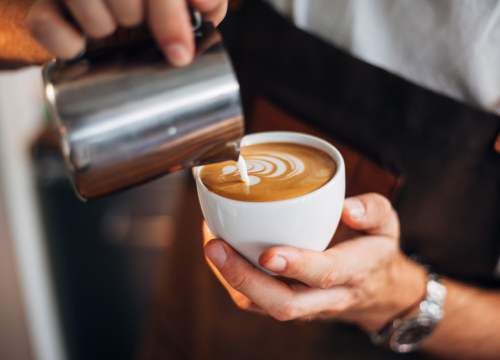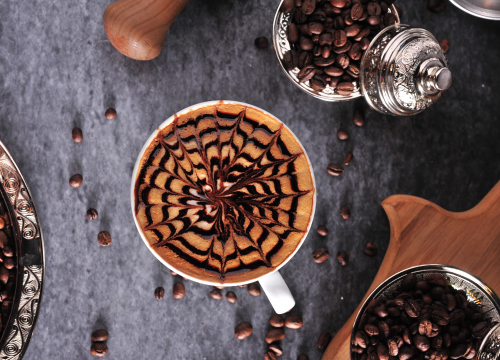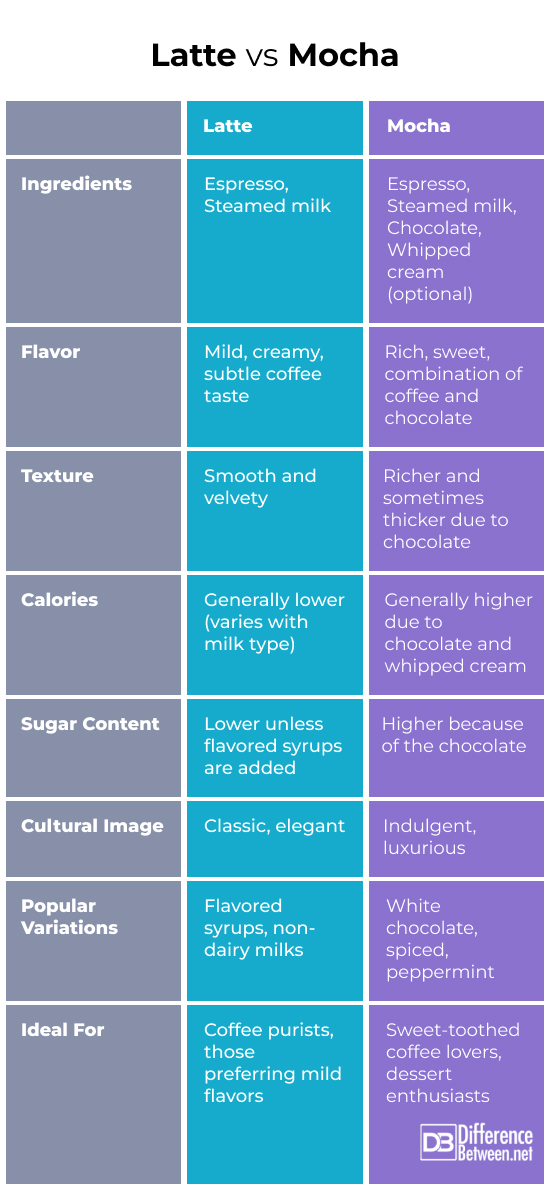Difference Between Latte and Mocha
Many people depend on coffee in the morning. This global phenomenon is well-prepared and flavored across cultures. Latte and Mocha are important to this rich coffee culture and enjoyed globally.
The smooth Latte shows how simple coffee can be magnificent. It means “milk coffee” in Italian. Its warm espresso-steamed milk combination and subtle caffeine boost make it popular.
For coffee and chocolate lovers, the Mocha (Caffè Mocha) is wonderful. Mocha, a Yemeni coffee capital, inspired this rich and stimulating cocktail with espresso, chocolate, and milk.
Modern coffee menus feature the Latte and Mocha, each with its own story and flavor. We find their differences, similarities, and coffee crafting passion.

What is a Latte?
Definition and Origin
The Italian word for latte is ‘Caffè Latte,’ which means coffee with milk. Italian ‘latte’ means’milk.’ This Italy-born drink was usually served at breakfast. Late in the 20th century, the Latte became popular in the US, where it evolved into the form we know today.
Typical Latte Ingredients:
Espresso: Hot water forced through finely ground coffee beans to concentrate it.
Steamed Milk: Creamy warm milk frothed.
For personalization, add flavored syrups or spices like cinnamon.
Preparation Method
- Brew one or two espresso shots.
- While the espresso brews, steam the milk until it’s hot and creamy.
- Add heated milk to espresso. Espresso to milk should be one-third to two-thirds.
- Many drinks have a little milk foam on top.
- Flavour Profile and Variations
Latte creaminess is famous. Rich, powerful espresso and gentle sweetness and smoothness of milk create a balanced flavor. It’s popular among folks who like a softer coffee taste than other espresso-based drinks.
Latte variations include:
- Flavored Lattes: Add vanilla, caramel, or hazelnut syrup to lattes.
- Iced Latte: An iced latte is excellent for warmer weather.
- Non-Dairy Lattes: Almond, soy, or oat milk non-dairy lattes.
- Latte Art: Pouring heated milk into espresso to create designs is called latte art.
Each variant provides a distinctive take on the traditional Latte, making it possible to satisfy a diverse range of preferences and tastes.

What is a Mocha?
Definition and Origin
Chocolate-flavored mochas are coffee drinks. The name stems from Mocha, Yemen, an early coffee trade location with unusual beans. The rich flavors of coffee and chocolate make modern mochas delectable.
Typical Mocha ingredients:
- Espresso is strong, flavorful coffee.
- Steamed Milk: Creamy espresso companion.
- Chocolate: Chocolate syrup, cocoa powder, or dark chocolate flavor it.
- For enhanced delight, add whipped cream.
Preparation Method
- Start with espresso shot.
- Mix espresso with chocolate syrup or melted chocolate. Taste and adjust amount.
- Adding hot, frothy milk is ideal.
- Balance coffee, chocolate, and milk flavors by gently adding hot milk to the chocolate-espresso combination.
- The drink usually has whipped cream and cocoa powder or chocolate shavings on the top.
Strong espresso and sweet chocolate form a creamy and rich mocha. It’s popular with coffee-dessert lovers.
Mocha variations include:
- White chocolate mocha: Sweeter, creamier.
- Spiced Mocha: Warm and fragrant cinnamon or nutmeg.
- Peppermint Mocha: Holiday fave.
- Iced mochas are excellent in summer.
- Vegan Mocha: Diet-friendly milk and chocolate.
This selection pleases coffee and chocolate lovers.
Similarities Between Latte and Mocha:
- Both start with a creamy espresso shot, the heart of any good coffee narrative.
- The Magic Touch: Creamy steamed milk comforts them and smooths every sip.
- Coffee Your Way: Love vanilla? Almond milk? They say, “Sure, let’s mix it up!”
- World Coffee Crushes: The world loves Lattes and Mochas from Rome to Rio.
- They’re everywhere: They’re waiting for you at a cozy corner café or a busy city coffee chain.
- Fan faves: Most coffee lovers adore at least one of these.
- Summer or Winter Ready: Iced or hot, they suit your mood and weather.
Differences Between Latte and Mocha
Ingredient Differences
Steamed milk and espresso make a latte.
Mocha: Chocolate syrup, powder, or melted, topped with whipped cream.
Compare taste and flavor
Latte: Milk softens espresso’s flavor, making it creamy and mild.
Mocha: Chocolate makes it sweeter and dessert-like. Chocolate enhances espresso.
Nutritional Differences
Latte: Low in calories and sugar unless flavored syrups are added.
Mocha: Chocolate and whipped cream make mochas more calorie and sugary.
Cultural significance and variations
Latte: A traditional, simplistic coffee drink with modest changes like flavor infusions or milk replacements.
Mocha: More indulgent and luxurious; variations may include various chocolate or spices.
Latte vs Mocha

Summary
Coffee culture stars Latte and Mocha. Amazing how a simple drink can reveal stories. The Latte’s espresso-milk waltz is comforting and inviting. Pure coffee with a dash of milk is ideal.
Mochas are fun coffees. Chocolate adds richness to the coffee gathering. On days when you say, “Why not treat myself?” the Mocha is a dessert in a cup.
Which one will it be? Simple Latte or robust Mocha? Enjoy each sip as it tells its story throughout the daily routine. You will have a great experience with coffee, regardless matter whether you choose a latte or a mocha.
FAQs
Which is stronger, mocha or latte?
- Well, it’s like asking whether a bear or a lion is stronger! Both Mocha and Latte start with espresso, so their caffeine punch is similar. But, if you’re talking about the boldness of flavor, Mocha takes the crown with its chocolatey depth.
What is the difference between a latte and a mocha with chocolate?
- Imagine a Latte as a serene lake, and a Mocha is that lake with a chocolate waterfall pouring into it. The key difference? That delicious, indulgent chocolate in the Mocha.
What’s the difference between a latte, mocha, and macchiato?
- Here’s the coffee trio: A Latte is like a soft blanket of milk over espresso. Mocha adds a chocolate party to that mix. And Macchiato? It’s espresso with just a dot of milk – like a lone cloud in a clear sky.
What’s the difference between a latte and a mocha at McDonald’s?
- At McDonald’s, the Latte is your classic, straightforward coffee and milk duo, while their Mocha adds a swirl of sweet chocolate to the mix. It’s like choosing between a classic burger and one with a special sauce!
Which tastes better, mocha or latte?
- Ah, the eternal question! It’s like asking if pizza is better than pasta. It all boils down to your taste buds. Crave straightforward coffee? Go Latte. But if it’s a sweet tooth you’re looking to satisfy, Mocha’s your best bud.
Which is better, mocha, latte, or cappuccino?
- Better? That’s like choosing a favorite child! Mocha is sweet, Latte is smooth, and Cappuccino? It’s frothy and bold. Your choice depends on your mood – sweet, smooth, or frothy?
Is a cappuccino better than a latte?
- Better is a tricky word in the coffee world. Cappuccino is frothier with a stronger coffee flavor, while a Latte is more about the harmony of milk and coffee. It’s like comparing a feather pillow to a memory foam one – both comfy, just different!
Is Matcha the same as mocha?
- Oh, worlds apart! Matcha is a type of green tea, vibrant and earthy. Mocha? That’s your coffee-chocolate blend. It’s like comparing a green meadow to a chocolate fountain!
What has more caffeine, latte or mocha?
- Since both are based on espresso, their caffeine levels are in the same ballpark. But remember, the chocolate in Mocha doesn’t add any extra caffeine, just extra sweetness and smiles.
- Difference Between Suicide and Euthanasia - May 22, 2024
- Difference Between Vitamin D and Vitamin D3 - May 21, 2024
- Difference Between Running Shoes and Walking Shoes - April 30, 2024
Search DifferenceBetween.net :
Leave a Response
References :
[0]Image credit: https://www.canva.com/photos/MAEELgNYzwc-barista-pouring-latte-art/
[1]Image credit: https://www.canva.com/photos/MAEqr6rqGIs-mocha-coffee/
[2]Morris, J. (2013). The Espresso Menu: An International History. In R. W. Thurston, J. Morris, & S. Steiman (Eds.), Coffee: A Comprehensive Guide to the Bean, the Beverage, and the Industry (pp. 262-279). Rowman & Littlefield Publishers.
[3]Tekulsky, M. (2013). Hot Drinks Made with Espresso. In Making Your Own Gourmet Coffee Drinks: Espressos, Cappuccinos, Lattes, Mochas, and More. Simon and Schuster.
[4]1 Morris, J. (2013). The Espresso Menu: An International History. In R. W. Thurston, J. Morris, & S. Steiman (Eds.), Coffee: A Comprehensive Guide to the Bean, the Beverage, and the Industry (pp. 262-279). Rowman & Littlefield Publishers.
[5]2 Morris, J. (2013). The Espresso Menu: An International History. In R. W. Thurston, J. Morris, & S. Steiman (Eds.), Coffee: A Comprehensive Guide to the Bean, the Beverage, and the Industry (pp. 262-279). Rowman & Littlefield Publishers.
[6]3 Morris, J. (2013). The Espresso Menu: An International History. In R. W. Thurston, J. Morris, & S. Steiman (Eds.), Coffee: A Comprehensive Guide to the Bean, the Beverage, and the Industry (pp. 262-279). Rowman & Littlefield Publishers.
[7]4 Tekulsky, M. (2013). Hot Drinks Made with Espresso. In Making Your Own Gourmet Coffee Drinks: Espressos, Cappuccinos, Lattes, Mochas, and More. Simon and Schuster.
[8]5 Tekulsky, M. (2013). Hot Drinks Made with Espresso. In Making Your Own Gourmet Coffee Drinks: Espressos, Cappuccinos, Lattes, Mochas, and More. Simon and Schuster.
[9]6 Tekulsky, M. (2013). Hot Drinks Made with Espresso. In Making Your Own Gourmet Coffee Drinks: Espressos, Cappuccinos, Lattes, Mochas, and More. Simon and Schuster.
[10]7 Morris, J. (2013). The Espresso Menu: An International History. In R. W. Thurston, J. Morris, & S. Steiman (Eds.), Coffee: A Comprehensive Guide to the Bean, the Beverage, and the Industry (pp. 262-279). Rowman & Littlefield Publishers.
[11]8 Tekulsky, M. (2013). Hot Drinks Made with Espresso. In Making Your Own Gourmet Coffee Drinks: Espressos, Cappuccinos, Lattes, Mochas, and More. Simon and Schuster.
[12]9 Tekulsky, M. (2013). Hot Drinks Made with Espresso. In Making Your Own Gourmet Coffee Drinks: Espressos, Cappuccinos, Lattes, Mochas, and More. Simon and Schuster.
[13]10 Tekulsky, M. (2013). Hot Drinks Made with Espresso. In Making Your Own Gourmet Coffee Drinks: Espressos, Cappuccinos, Lattes, Mochas, and More. Simon and Schuster.
